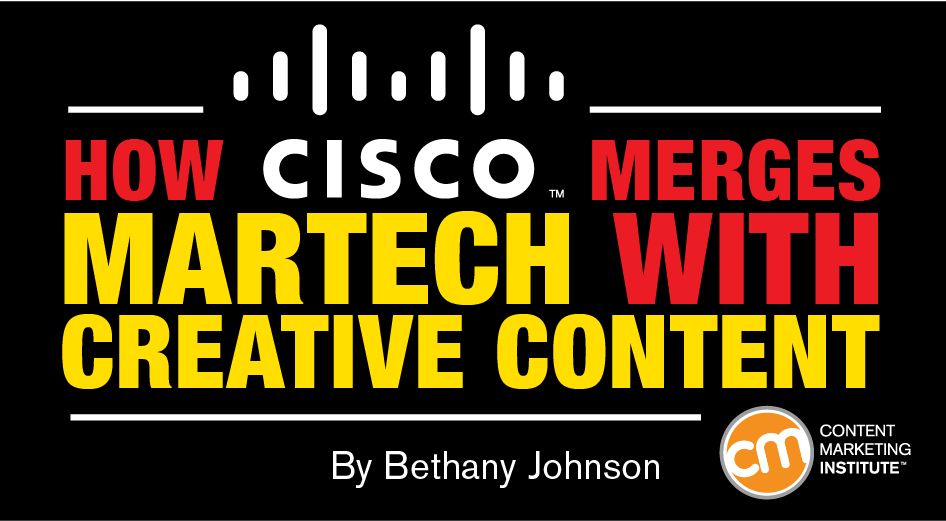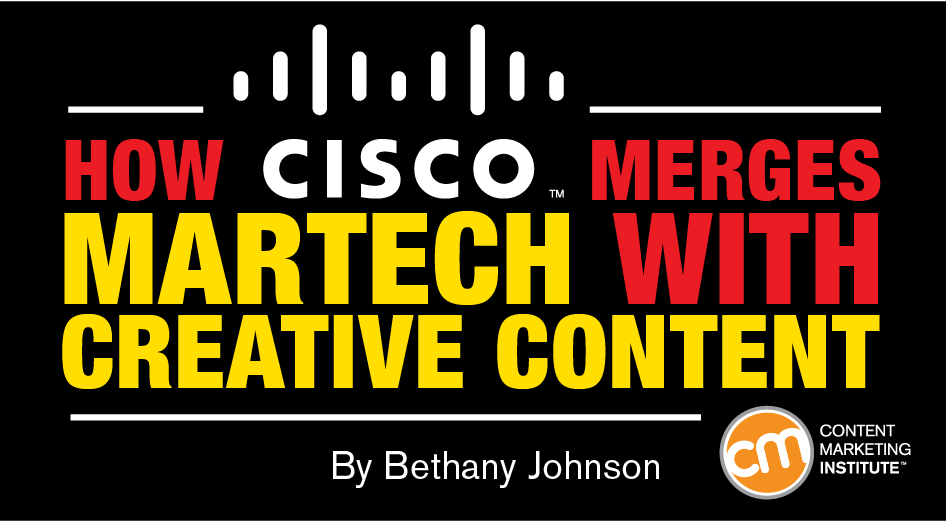Bob Meindl, Cisco marketing director, and Jenny Hooks, Cisco marketing manager, describe the revelation in their joint 2018 Intelligent Content Conference, Beauty and the Beast: Creating the Balance Between Content Innovation and Martech Capabilities. “Like many large B2B companies, we focused on product marketing, and each business unit would market to customers on their own,” Bob says. Everything is now purpose-built for the customer and for the channel and for the experience that we’re trying to drive.” Plan the experience based on personas and channel strategies Designing a personalized red-carpet experience for everyone in your database, no matter how manageable the list, would be overwhelming. For example, you wouldn’t expect a CIO, a data center manager, and a network buyer to display the same digital behavior, but even though they have differing motivations, they sometimes tackle top tasks similarly. Although 95% of visitors get the same experience on Cisco.com today, the team’s working hard to change that, starting with recognizing the visitor’s country and directing that user to the country-appropriate site. The IDs help the team understand which content visitors engage with and what channel they’re coming from. Personas in practice Bob and Jenny shared an example of one of Cisco’s personas to show how the new process revolves around the customer rather than the products. “At the end of the day, we want Nigel to buy a product from Cisco, so at some point, you have to work that in,” Bob says. Too often, we create content and then personalize it for the sake of personalization, not truly for the benefit of both audience and business. Her work empowers marketers to rethink interrupt advertising in favor of original content that converts passive readers into active followers.

If you could build the ideal multi-industry global conglomerate from scratch, scaling it to over 700 product families, would you let each one of those 700 product managers target the same customer separately?
Of course you wouldn’t.
Why then do so many enterprise brands find themselves in a similar pickle?
Three years ago, the Cisco marketing team woke up to this real-life situation. Bob Meindl, Cisco marketing director, and Jenny Hooks, Cisco marketing manager, describe the revelation in their joint 2018 Intelligent Content Conference, Beauty and the Beast: Creating the Balance Between Content Innovation and Martech Capabilities.
“Like many large B2B companies, we focused on product marketing, and each business unit would market to customers on their own,” Bob says. “To be fair, they thought about the customer, and understood the customer, but only from the very specific lens of their product.”
Unfortunately, the disconnect led to multiple marketing programs within Cisco targeting an individual prospect from many angles, resulting in an experience that looked fragmented, felt uncoordinated, and even sometimes delivered conflicting information.
The solution they found flipped the “create content first, ask questions later” approach all too common at Cisco – and so many other companies. Putting content creation last ended up helping the team scale its processes and end the confusing experiences that sprang from muddled marketing silos.
HANDPICKED RELATED CONTENT:
Restructure around customers, not products
All product managers consider their widget customer-centric because it solves a client’s problem. Of course, they’re right. But what often emerges from that mindset is the impulse to develop content about how the product helps the customer – and then figure out who to target it to.
While many content marketers know to start with the customer when creating their strategy, many product marketing-driven B2B organizations struggle to start their content planning from that perspective.
Cisco’s CMO tasked a team of 20 marketing and communications leaders from across the company to set out to reverse the framework and create a genuine audience-first model instead. Today, the content process starts with a detailed analysis of the audience before any content gets created.
The marketing function rallied around the customer-centric perspective from the executive to the individual contributor levels. In-country teams added writing capabilities and built digital marketing functions from scratch. “This was a huge change for us, putting the customer at the center of everything,” Bob says.
The audience-first process adopted by the restructured organization includes:
- Identification of personas
- Identification of channels
- Creation or discovery of the journey and experiences
- Creation of the content

The framework appears simple, but in practice the many decisions and people involved complicate the process. If you implement it, expect hurdles and snags, Bob and Jenny say. But stay committed to the process for the benefit of your customer. Here’s how.
Agree on segmentation criteria and create persona categories
We all have misconceptions about who our audiences really are and what they truly want. Marketers project attributes, pain points, and desires onto their ideal persona instead of uncovering true “care-abouts,” as Cisco describes them.
To get better acquainted with its target audiences, Cisco worked with the Buyer Persona Institute to conduct blind interviews with customers who operated in companies of varying sizes, industries, and countries. These interviews helped the team understand their audience’s real needs. “We (found) out what they care about in their own language, not what we think they care about, but what they actually care about in their work,” Bob says. “We augmented this with hard data on customer behavior collected from various first- and third-party sources.”
With that information, Jenny’s team was equipped to create a smart channel strategy that meets those customers with the right content, through the right channel, at precisely the right moment.
Build a channel strategy based upon newly formed personas and ‘care-abouts’
Accommodating a seamless experience across channels means meeting contacts where they are instead of creating something and hoping to lure eyeballs toward it, Jenny says. That’s the difference between a successful omnichannel strategy and wasted activity.
“Our muscle memory is to produce a piece of content and then ask, ‘What should we do with it?’” she says. “We are really trying to change that. Everything is now purpose-built for the customer and for the channel and for the experience that we’re trying to drive.”

COMMENTS